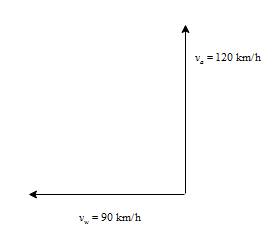
Concept explainers
For Questions 20—21, recall that the resultant V of two vectors A and B at right angles to each other is found using the Pythagorean theorem:
Calculate the resulting speed of an airplane with an airspeed of 120 km/h pointing due north when it encounters a wind of 90 km/h directed from the west. (Recall, speed is the magnitude of velocity.)
Magnitude of resultant speed of airplane.
Answer to Problem 20A
Resultant velocity is,
Explanation of Solution
Given :
Velocity of airplane in north direction is,
Formula used :
Where, R is resultant vector, A and B are two vectors which are perpendicular to each other.
Calculation :
Velocity of airplane and velocity of wind is represented by below figure.

Here, both velocity are perpendicular to each other.
Therefore, magnitude of their resultant velocity will be,
Now, substituting the value of
Conclusion :
Therefore, magnitude of resultant velocity airplane is 150 km/h.
Chapter 5 Solutions
Conceptual Physics C2009 Guided Reading & Study Workbook Se
Additional Science Textbook Solutions
College Physics: A Strategic Approach (3rd Edition)
Microbiology with Diseases by Body System (5th Edition)
Campbell Essential Biology (7th Edition)
Microbiology: An Introduction
Genetic Analysis: An Integrated Approach (3rd Edition)
Biology: Life on Earth (11th Edition)
- 3arrow_forward13. After a gust of wind, an orb weaver spider with a mass of 35 g, hanging on a strand of web of length L = .420 m, undergoes simple harmonic motion (SHO) with an amplitude A and period T. If the spider climbs 12.0 cm up the web without perturbing the oscillation otherwise, what is the period of oscillation, in Hz to three significant figures?arrow_forward15. An object of mass m = 8.10 kg is attached to an ideal spring and allowed to hang in the earth's gravitational field. The spring stretches 23.10 cm before it reaches its equilibrium position. The mass then undergoes simple harmonic motion with an amplitude of 10.5 cm. Calculate the velocity of the mass in m/s at a time t= 1.00s to three significant figures.arrow_forward
- please solve and answer the question correctly. Thank you!!arrow_forward18arrow_forward1. Some 1800 years ago Roman soldiers effectively used slings as deadly weapons. The length of these slings averaged about 81 cm and the lead shot that they used weighed about 30 grams. If in the wind up to a release, the shot rotated around the Roman slinger with a period of .14 seconds. Find the maximum acceleration of the shot before being released in m/s^2 and report it to two significant figures.arrow_forward
- 16arrow_forward11. A small charged plastic ball is vertically above another charged small ball in a frictionless test tube as shown in the figure. The balls are in equilibrium at a distance d= 2.0 cm apart. If the charge on one ball is tripled, find the new equilibrium distance between the balls in cm and report it to the proper number of significant figures.arrow_forward12. The electric field at a point 1.3 cm from a small object points toward the object with a strength of 180,000 N/C. Find the object's charge q, in nC to the proper number of significant figures. k = 1/4πε0 = 8.99 × 10^9 N ∙ m^2/C^2arrow_forward
- 14. When the potential difference between the plates of an ideal air-filled parallel plate capacitor is 35 V, the electric field between the plates has a strength of 670 V/m. If the plate area is 4.0 × 10^-2 m^2, what is the capacitance of this capacitor in pF? (ε0 = 8.85 × 10^-12 C^2/N ∙ m^2)arrow_forward10. A small styrofoam ball of mass 0.500 g is placed in an electric field of 1140 N/C pointing downward. What excess charge must be placed on the ball for it to remain suspended in the field? Report your answer in micro-Coulombs to three significant figures.arrow_forward2arrow_forward
 College PhysicsPhysicsISBN:9781305952300Author:Raymond A. Serway, Chris VuillePublisher:Cengage Learning
College PhysicsPhysicsISBN:9781305952300Author:Raymond A. Serway, Chris VuillePublisher:Cengage Learning University Physics (14th Edition)PhysicsISBN:9780133969290Author:Hugh D. Young, Roger A. FreedmanPublisher:PEARSON
University Physics (14th Edition)PhysicsISBN:9780133969290Author:Hugh D. Young, Roger A. FreedmanPublisher:PEARSON Introduction To Quantum MechanicsPhysicsISBN:9781107189638Author:Griffiths, David J., Schroeter, Darrell F.Publisher:Cambridge University Press
Introduction To Quantum MechanicsPhysicsISBN:9781107189638Author:Griffiths, David J., Schroeter, Darrell F.Publisher:Cambridge University Press Physics for Scientists and EngineersPhysicsISBN:9781337553278Author:Raymond A. Serway, John W. JewettPublisher:Cengage Learning
Physics for Scientists and EngineersPhysicsISBN:9781337553278Author:Raymond A. Serway, John W. JewettPublisher:Cengage Learning Lecture- Tutorials for Introductory AstronomyPhysicsISBN:9780321820464Author:Edward E. Prather, Tim P. Slater, Jeff P. Adams, Gina BrissendenPublisher:Addison-Wesley
Lecture- Tutorials for Introductory AstronomyPhysicsISBN:9780321820464Author:Edward E. Prather, Tim P. Slater, Jeff P. Adams, Gina BrissendenPublisher:Addison-Wesley College Physics: A Strategic Approach (4th Editio...PhysicsISBN:9780134609034Author:Randall D. Knight (Professor Emeritus), Brian Jones, Stuart FieldPublisher:PEARSON
College Physics: A Strategic Approach (4th Editio...PhysicsISBN:9780134609034Author:Randall D. Knight (Professor Emeritus), Brian Jones, Stuart FieldPublisher:PEARSON





